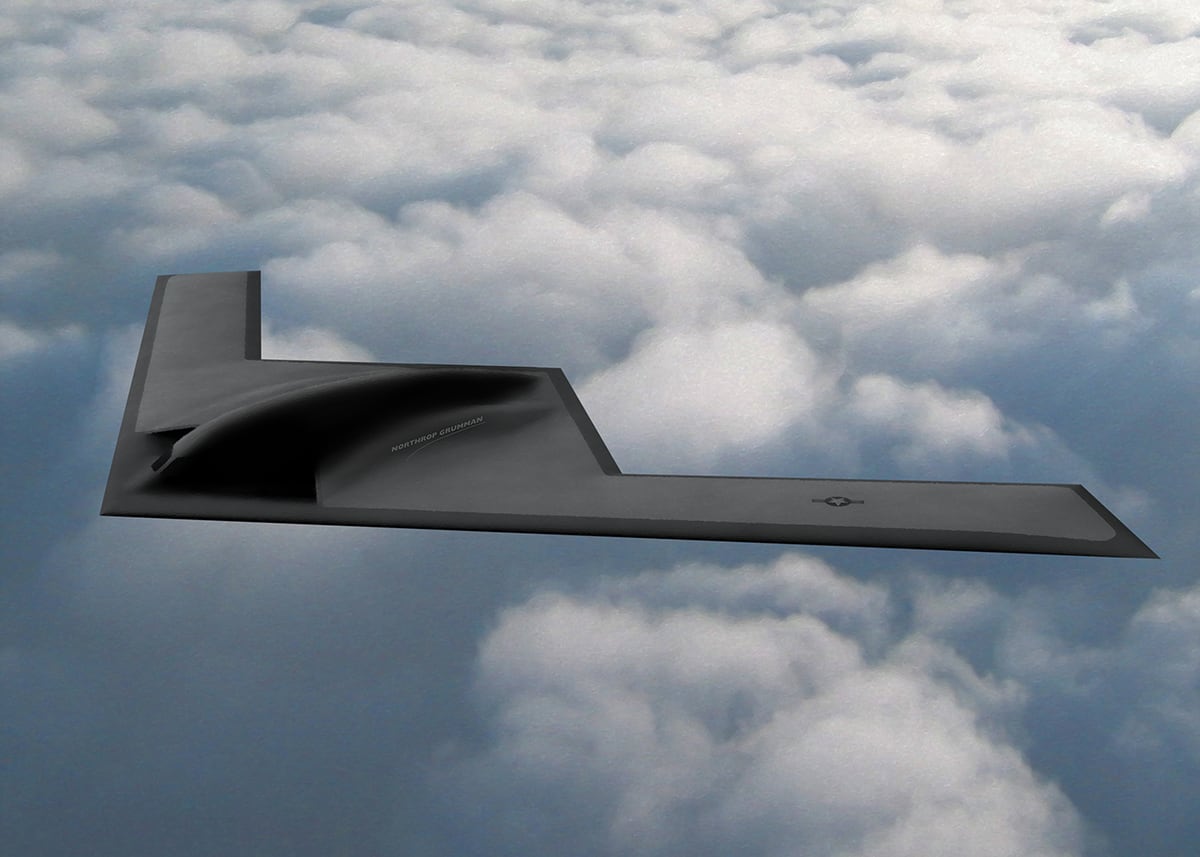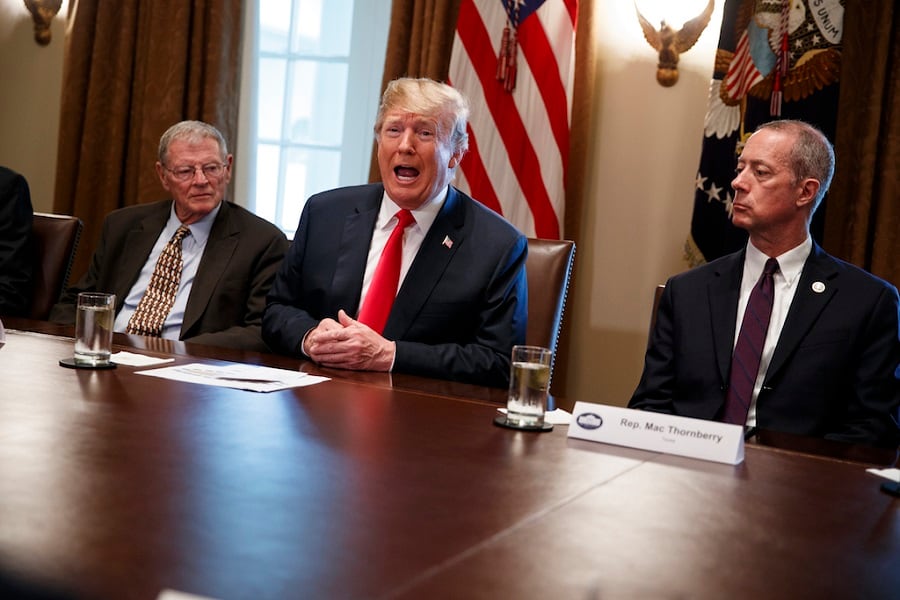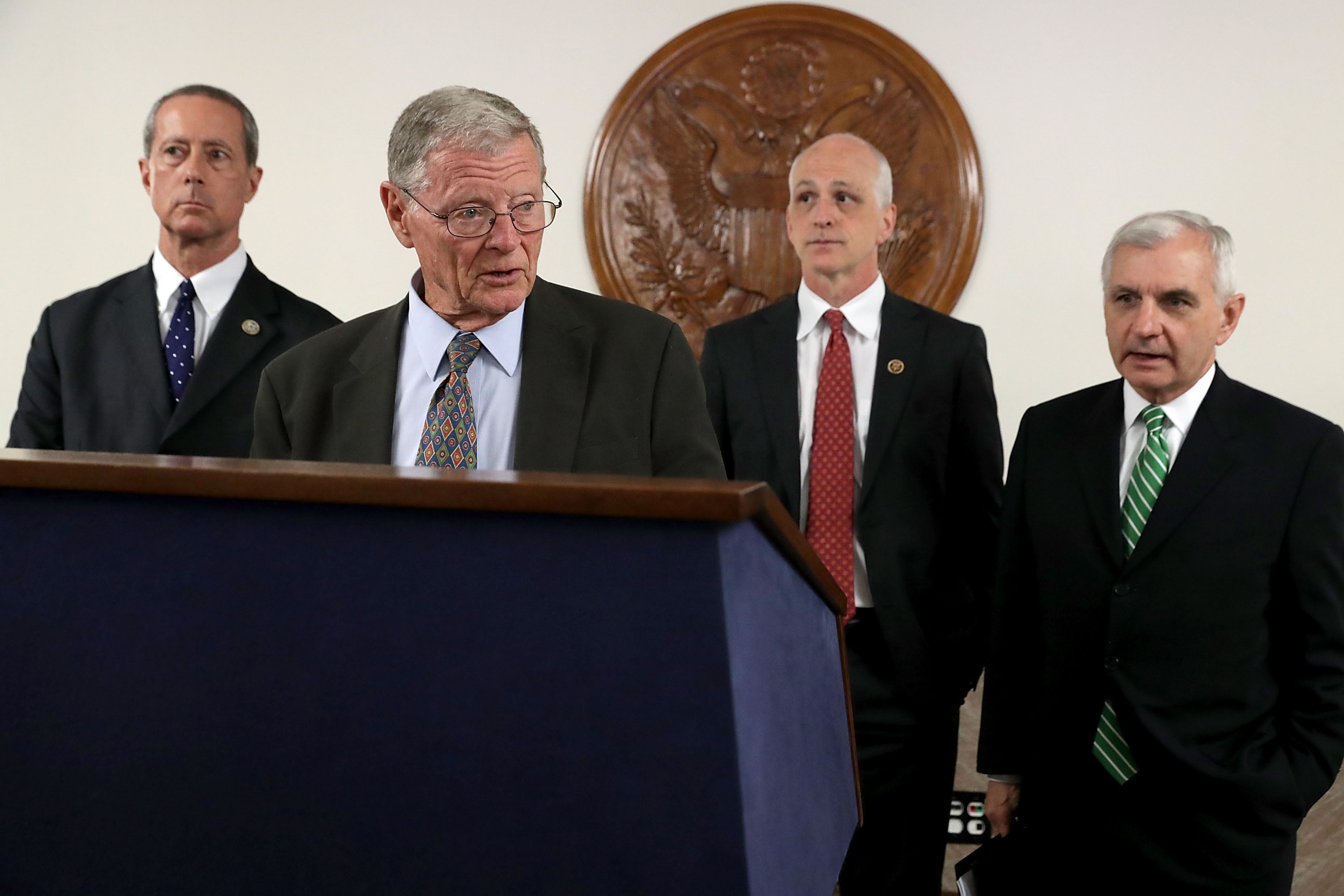WASHINGTON — Sen. Jim Inhofe, the staunch Republican Senate Armed Services Committee chairman, and Rep. Adam Smith, the Washington Democrat and likely next chairman of the House Armed Services Committee, are on a collision course for 2019.
Inhofe on Tuesday released an outline of priorities for the 2020 National Defense Authorization Act, signaling plans to aggressively negotiate over the first defense policy bill from a divided Congress since 2014.
In an interview Tuesday, Inhofe, R-Okla., outlined positions at odds with Smith to defend the size of the defense budget, to defend the Trump administration’s ban on transgender troops and to modernize America’s nuclear arsenal.
“What he’s doing is taking the thing that’s singularly the biggest threat to us and saying: ‘We want to make America more vulnerable,' ” Inhofe said of Smith’s position on nuclear weapons. Inhofe called the nuclear triad “the most important area of modernization.”
Whereas Smith — the HASC’s ranking member and likely chairman when Democrats take over the House in January — has advocated for a smaller nuclear arsenal to serve as a deterrent and not an overwhelming force to win a nuclear war, Inhofe — who succeeded the late Sen. John McCain, R-Ariz., as chairman — sees Russia and China as poised to overtake America and its crumbling nuclear weapons infrastructure.
“They started out with no triad, and now they’re up there and knocking on our door — so that’s the area where we have to [invest],” Inhofe said. “I don’t know why Smith or anyone else would single out nuclear modernization as an area to cut. That allows someone who’s not otherwise a formidable opponent to destroy the United States of America.”
RELATED

Whereas Smith has vowed to fight the Trump administration’s ban on transgender troops, calling it “bigoted" and "unconstitutional,” Inhofe signaled he would go to bat for the ban and questioned Democratic resolve on the issue.
“Transgender is one [issue] I don’t think he has the support for,” Inhofe said of Smith. “Democrats though, they surprise you in how disciplined they are, and they can, behind closed doors, decide ‘let’s do this for that particular population.’ They can do it, and that doesn’t mean that’s where their heart is.”
“If you look at the president, [Defense Secretary Jim] Mattis, [Secretary of State Mike] Pompeo, me — we’re all opposed to having them serving in the military,” Inhofe said of transgender individuals.
The Pentagon initially lifted its ban on transgender troops serving openly in the military in 2016, under the Obama administration. But the current administration revisited that policy, with President Donald Trump ultimately issuing an order banning most transgender troops from serving in the military except under limited circumstances. Several lawsuits were filed over the administration’s policy change, with lower courts all ruling against the Trump administration.
The Trump administration asked the Supreme Court on Friday to issue an unusually quick ruling on the matter.
Otherwise, Inhofe’s NDAA would also be a modernization bonanza, accelerating F-35 fighter jet purchases to triple the fleet by 2024; accelerating fielding of the B-21 Raider stealth bomber to complete five squadrons; and moving the goal line for a 355-ship naval fleet up to 2040 (versus 2060). He also prioritizes test facilities for a nascent hypersonic weapon.

“Other countries are competing with us in the number of fighters and the quality of fighters, and we want to stay ahead,” Inhofe said, adding that China’s ambitious naval modernization program likewise justifies boosting America’s fleet.
RELATED

Will Inhofe’s strategy prove effective?
A former readiness subcommittee chairman, Inhofe would continue Mattis' emphasis on operations and maintenance spending to address what he sees as former President Barack Obama’s tragic underinvestment. “We lost lives," Inhofe said. "Kids were using equipment that didn’t work. Marine pilots — below 50 percent of their F-18s could fly because of maintenance problems.”
How much Inhofe can achieve from his opening gambit remains to be seen. Midterm elections earned Democrats the House, but Republicans still have the Senate and Trump’s veto pen.
One obstacle is the Budget Control Act, which remains in force for 2020 and 2021 and requires congressional leaders negotiate a new deal to lift caps on defense and nondefense discretionary spending.
Inhofe’s aggressive negotiating position on the BCA is to remove spending limits on defense next year and leave caps on all other federal funding. This will be a non-starter for Democrats, who fought for parity between defense and nondefense spending, and are likely to use their new leverage to do so again.
Here, Inhofe and other defense hawks face an uphill battle because the White House is mulling a $700 billion defense budget — below $716 billion for 2019 and the $733 billion that the Department of Defense planned for 2020.
Though the White House ordered the Pentagon to prepare a $700 billion budget, Inhofe felt Trump would not go through with it when he proposes his budget to Congress next year. “It takes you back and undoes all the recovery we had in fiscal years ’18 and ’19, and that’s why I just can’t give credibility to that,” he said.
To argue for a defense budget boost, Inhofe plans to use the bipartisan National Defense Strategy Commission’s recent recommendations as a blueprint for the next NDAA. The 120-page report warns that America faces a “crisis of national security,” thanks to growing threats from Russia and China as well as aging American assets.
Timing also matters to Inhofe. After Congress this year passed the NDAA at the earliest date in 40 years, Inhofe wanted the Senate to pass its next NDAA by late spring. That’s to get the Pentagon on-time funding, but it’s also to establish the committee’s top line ahead of appropriators — who aren’t necessarily aligned with a $733 billion.
“You have to sell to appropriators, and we have such a strong case, and that case is the credibility of this report,” Inhofe said, brandishing the study.
RELATED

The NDAA has passed for 58 consecutive years, and to maintain the streak will require Senate Republicans and House Democrats to find common ground. Inhofe bets his national security argument will win enough Democrats that defense hawks prevail.
“This isn’t abortion that we are talking about, this isn’t gun control that we are talking about — this is defending America,” Inhofe said. “There’s a propensity for a larger number of Democrats to leave their party on this issue because the public at home recognizes the threat is real.”
To be sure, not every item on Inhofe’s list seems controversial. Likely candidates for bipartisan cooperation include his emphasis on readiness spending, reforms aimed at streamlining and simplifying the contracting process, and his support for the Pentagon’s first-ever audit.
But Smith is likely to dispute Inhofe’s view the Pentagon should keep the savings it finds through management reforms.
Defense leaders have called for 3 to 5 percent real budget growth to maintain the military’s strategic edge, Inhofe noted, adding: “Any savings that comes from acquisition reform should go to that."
The Associated Press contributed to this report.
Joe Gould was the senior Pentagon reporter for Defense News, covering the intersection of national security policy, politics and the defense industry. He had previously served as Congress reporter.




